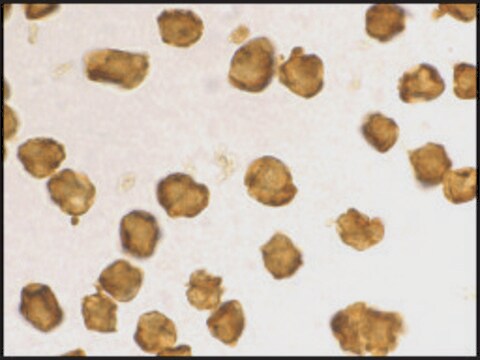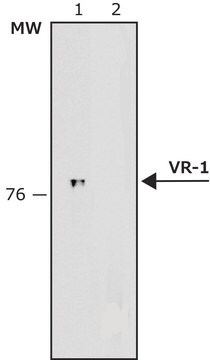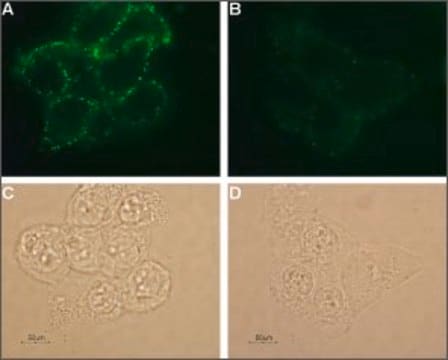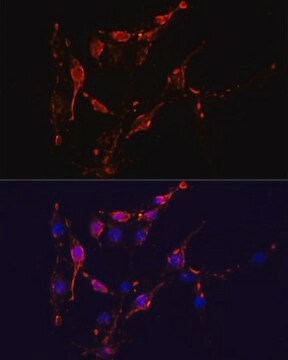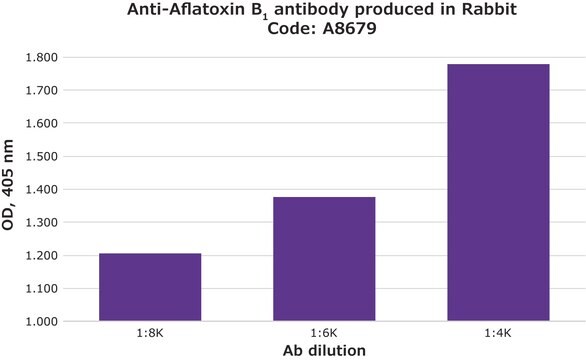推荐产品
生物源
mouse
品質等級
抗體表格
purified antibody
抗體產品種類
primary antibodies
無性繁殖
29C8, monoclonal
分子量
calculated mol wt 64.47 kDa
observed mol wt ~65 kDa
純化經由
using protein G
物種活性
human
物種活性(以同源性預測)
bovine, porcine, canine, monkey, mouse
包裝
antibody small pack of 100
技術
ELISA: suitable
immunoprecipitation (IP): suitable
western blot: suitable
同型
IgG2cκ
表位序列
N-terminal
Protein ID登錄號
UniProt登錄號
儲存溫度
2-8°C
基因資訊
human ... METTL3(56339)
特異性
Clone 29C8 is a mouse monoclonal antibody that detects METTL3. It targets an epitope within 15 amino acids from the N-terminal region.
免疫原
Ovalbumin-conjugated linear peptide corresponding to 15 amino acid from the N-terminal region of human METTL3.
應用
Quality Control Testing
Evaluated by Western Blotting in lysate from wild-type C643 cells.
Western Blotting Analysis: A 1:1,000 dilution of this antibody detected METTL3 in lysate from wild-type C643 cells, but not in lysate from METTL3 knockout C643 cells.
Tested Applications
Immunoprecipitation Analysis: A representative lot immunoprecipitated METTL3 in Immunoprecipitation applications (Scholler, E., et al. (2018). RNA. 24(4):499-512).
Western Blotting Analysis: A representative lot detected METTL3 in Western Blotting applications (Scholler, E., et al. (2018). RNA. 24(4):499-512).
ELISA Analysis: A representative lot detected METTL3 in ELISA applications (Scholler, E., et al. (2018). RNA. 24(4):499-512).
Note: Actual optimal working dilutions must be determined by end user as specimens, and experimental conditions may vary with the end user.
Evaluated by Western Blotting in lysate from wild-type C643 cells.
Western Blotting Analysis: A 1:1,000 dilution of this antibody detected METTL3 in lysate from wild-type C643 cells, but not in lysate from METTL3 knockout C643 cells.
Tested Applications
Immunoprecipitation Analysis: A representative lot immunoprecipitated METTL3 in Immunoprecipitation applications (Scholler, E., et al. (2018). RNA. 24(4):499-512).
Western Blotting Analysis: A representative lot detected METTL3 in Western Blotting applications (Scholler, E., et al. (2018). RNA. 24(4):499-512).
ELISA Analysis: A representative lot detected METTL3 in ELISA applications (Scholler, E., et al. (2018). RNA. 24(4):499-512).
Note: Actual optimal working dilutions must be determined by end user as specimens, and experimental conditions may vary with the end user.
標靶描述
N6-adenosine-methyltransferase catalytic subunit (UniProt: Q86U44; also known as EC:2.1.1.348, Methyltransferase-like protein 3, hMETTL3, N6-adenosine-methyltransferase 70 kDa subunit, MT-A70) is encoded by the METTL3 (also known as MTA70) gene (Gene ID: 56339) in human. METTL3 heterodimerizes with METTL14 to form an antiparallel heterodimer, which constitutes an active methyltransferase that methylates adenosine residues at the N6 position of some RNAs and regulates various cellular processes, including differentiation of embryonic and hematopoietic stem cells, cortical neurogenesis, differentiation of T-cells, and primary miRNA processing. In response to UV caused DNA damage, METTL3 rapidly catalyzes the formation of m6A on poly(A) transcripts at DNA damage sites that leads to the recruitment of POLK to these sites. It is localized both in the cytoplasm and in the nucleus. It colocalizes with speckles in interphase nuclei. In response to UV irradiation, it is shown to colocalize to DNA damage sites. Its methyltransferase activity is inhibited by sumoylation. However, sumoylation does not affect its subcellular location or interaction with METTL14. Overexpression of METTL3 is reported in several human cancers and its knockdown is known to promote apoptosis. METTL3 is reported to be strongly and directly phosphorylated by ERK2 at serine 43, 50, and 525 and to a lesser extent by p38 and JNK. METTL3 phosphorylation increases its USP5-mediated deubiquitination that leads to its stabilization. Phosphorylation of METTL3 is reported to promote murine embryonic stem cell differentiation. Clone 29C8 is suitable for complex purification of both METTL3 and-14 and is useful in simultaneous analysis of both proteins. (Ref.: Sun, H-L., et al. (2020). Mol. Cell. 80(4); 633-647; Schöller, E., et al. (2018). RNA 24(4); 499-512; Wang, P., et al. (2016). Mol. Cell. 63(2); 306-317).
外觀
Purified mouse monoclonal antibody IgG2c in buffer containing 0.1 M Tris-Glycine (pH 7.4), 150 mM NaCl with 0.05% sodium azide.
重構
1.0 mg/mL. Please refer to guidance on suggested starting dilutions and/or titers per application and sample type.
儲存和穩定性
Recommended storage: +2°C to +8°C.
其他說明
Concentration: Please refer to the Certificate of Analysis for the lot-specific concentration.
免責聲明
Unless otherwise stated in our catalog or other company documentation accompanying the product(s), our products are intended for research use only and are not to be used for any other purpose, which includes but is not limited to, unauthorized commercial uses, in vitro diagnostic uses, ex vivo or in vivo therapeutic uses or any type of consumption or application to humans or animals.
未找到合适的产品?
试试我们的产品选型工具.
儲存類別代碼
12 - Non Combustible Liquids
水污染物質分類(WGK)
WGK 1
閃點(°F)
Not applicable
閃點(°C)
Not applicable
我们的科学家团队拥有各种研究领域经验,包括生命科学、材料科学、化学合成、色谱、分析及许多其他领域.
联系技术服务部门

